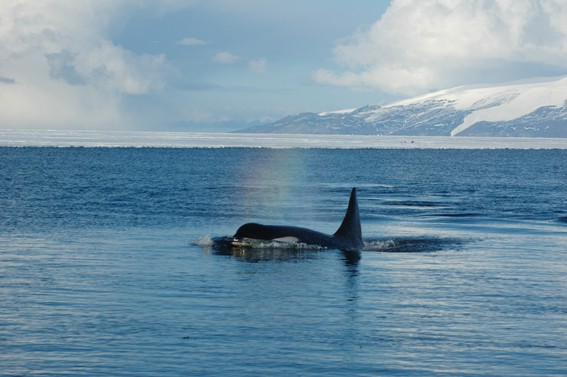An interview with David Ainley.
Imagine an ocean untouched by oil spills: a sea free of pollution, invasive species, dead zones, and over-exploitation; waters where marine animals exist in natural abundance and play ecological roles undimmed by mankind. Such a place may sound impossible in today’s largely depleted oceans, but it exists: only discovered in 1841, the Ross Sea spreads over nearly a million kilometers adjacent to the Antarctic continent. Here killer whales, penguins, sea birds, whales, and giant fish all thrive. However, even with its status as the world’s ‘last ocean’, the Ross Sea has not escaped human impact. Over the last 15 years commercial fisheries have begun to catch one of its most important species in the ecosystem to serve them up on the dinner plates of the wealthy.
“[The] Ross Sea is the last open ocean tract (i.e. not a reef) that still has a food web much like what one would expect the ‘Garden of Eden’ to have been like. That is: all the ‘fruits’ are still there, ready to be picked,” explains marine ecologist Dr. David Ainley in an interview with mongabay.com, adding that “the reason why it has yet to be depleted by humans is that the Antarctic Treaty prohibits mineral/oil extraction, and its remoteness from civilization, the extensive sea ice that covers it for a lot of the year, and its reputation for harsh weather.”
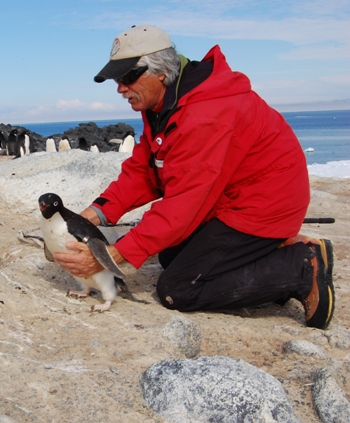 David Ainley with an Adelie penguin. Photo courtesy of David Ainley. |
However, like many remote places on Earth during the last century, humans have begun moving into the Ross Sea, not for oil and mineral riches, but for fish.
“The fact that all the large fish have been taken from the rest of the world ocean brought industrial fishing to the Ross Sea,” says Ainley. “Right now, while the fish are still plentiful, it’s easy to quickly fill holds of vessels in just a few weeks.”
Industrial fisheries mostly out of New Zealand are targeting the man-sized, slow growing Antarctic toothfish (Dissostichus mawsoni), or as it is known by its more palatable market name, the Chilean sea bass. Market-wise, the fish is lumped with a close-relative, the Patagonian toothfish, which has been largely depleted for consumption.
“These fish are the ‘sharks’ of the southern ocean, and thus play a critical role in the food web,” Ainley says. “The removal of sharks from other oceans has had dire ecological consequences, in some cases leading to the disappearance of species with which the sharks have no direct contact. This is because the sharks (toothfish) keep the populations of smaller predators in check.”
If the Antarctic toothfish are allowed to vanish due to overexploitation, Ainley says that the Ross Sea—now home to a unique species of killer whale, over a third of the world’s Adelie penguins, and over a quarter of the world’s emperor penguins—could no longer be considered an intact ecosystem, like stripping lions from the Serengeti or wolves from Alaska.
Economically, Ainley says, the Antarctic toothfish fishery is actually unviable: the cost of traveling and fishing in this remote sea actually outweighs the profit. But instead of giving up the catch, fisheries are now applying for sustainability certificates through the Marine Stewardship Council. If awarded—despite scientific concerns—the fisheries believe they can then up the already expensive price of $20-35 a pound for the species.
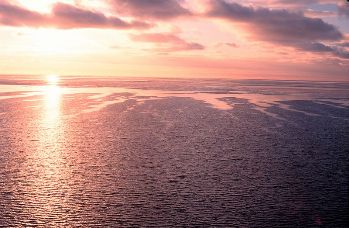 Sunset over the Ross Sea. Photo by: the National Oceanic and Atmospheric Association (NOAA). |
“Only very well-off persons can afford to eat this fish, which is served in many different ways (as Chilean sea bass)…but only little bites are affordable,” says Ainley.
Along with a variety of experts, Ainley is recommending that the Ross Sea become a marine protected area. While mining for resources is already banned in the Ross Sea and the Southern Ocean, Ainley says that “exploitation for the biotic resources of the Southern Ocean, however, is mostly a free-for-all (countries kill whales, or fish mostly to their hearts’ content). We hope that Convention for the Conservation of Antarctic Marine Resources (CCAMR) somehow develops the strength to establish a network of marine protected areas, and that the Ross Sea is one of them.”
To help the Ross Sea, Ainley recommends avoiding Chilean Sea bass entirely and, if possible, giving donations to help finish a film already shot, aptly titled Last Ocean.
For now the Ross Sea is “all nature, pure and simple”, Ainley explains. But it will take political will from many nations to keep it that way.
In a July 2010 interview with mongabay.com, David Ainley discusses the uniqueness of the Ross Sea, the ecological value of its Antarctic toothfish, the process of creating a marine protected area (MPA), and the choice between saving the sea or exploiting it.
AN INTERVIEW WITH DAVID AINLEY
Mongabay: What is your background?
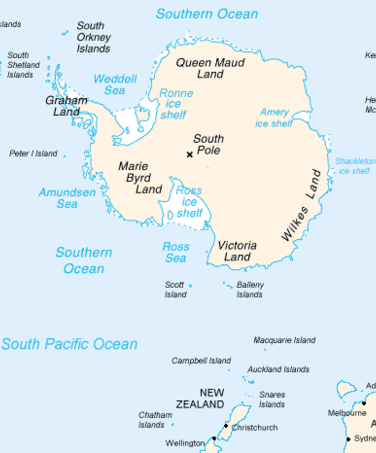 Map of Antarctica. Image courtesy of CIA World Factbook. |
David Ainley:I spent a lot of my growing years in the woods and shores of New England, and then the mountains of California. I went to college at Dickinson College in Pennsylvania, and graduate school (ecology, animal behavior) at John Hopkins University in Maryland. I was inspired to delve into the mysteries of marine birds by an [National Science Foundation] undergraduate assistantship on islands in the Bay of Fundy, Maine/New Brunswick. Have since been conducting research on marine birds, mammals and sharks for past 35 years: Antarctic, eastern tropical Pacific, California Current.
Mongabay: Many people have probably never heard of the Ross Sea. Where is it? What makes it unique ecologically?
David Ainley: The Ross Sea is about 2000 kilometers south of New Zealand, straddling the International Date Line. It is about the size of southern Europe, and is named after James Clark Ross, who led the first expedition to visit it 180 yeas ago (not so long ago!!). It is the most southerly water mass on Earth (to 78 S), and the site of all the ‘heroic’ Antarctic expeditions, led by the likes of Amundsen, Scott, Shackelton, Hillary, and Byrd. Its uniqueness stems from being the last intact open ocean ecosystem left on the Planet. The reason why it has yet to be depleted by humans is that the Antarctic Treaty prohibits mineral/oil extraction, and its remoteness from civilization, the extensive sea ice that covers it for a lot of the year, and its reputation for harsh weather discourages long-term visitation required of exploitation.
Mongabay: Can you tell us about your personal experience with the Ross Sea?
David Ainley: In graduate school I investigated the ecology of penguins living on the shores of the Ross Sea. This was at Cape Crozier, one of the “power spots” on the Planet, where incredible, life-denying forces of nature come together, yet the penguins more than persevere: 140 knot winds; the largest glaciers on Earth; in the shadows of some of the highest mountains in Antarctica, with names of Mt Terror and Mt Erebus; and an active volcano (Erebus), etc.
Then I became intrigued by what the penguins were doing during their non-breeding period of the year, when they head out to sea. So, I participated in several research cruises that crisscrossed the Ross Sea and surrounding waters, quantifying the abundance at sea of seabirds, seals and whales. Thereafter, I returned now and again to conduct research on the penguins, other seabirds, seals and whales.
THE LAST OCEAN
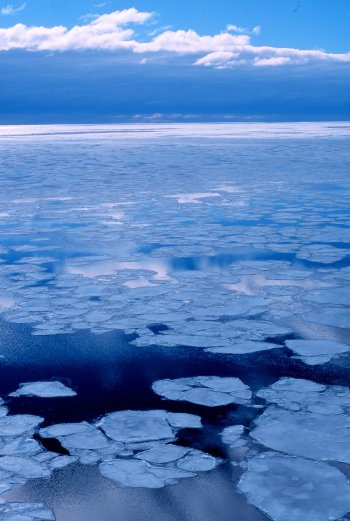 Pancake ice on the Ross Sea. Photo by: the National Oceanic and Atmospheric Association (NOAA). |
Mongabay: Why is the Ross Sea known as ‘the last ocean’?
David Ainley: Sobering as it is, the human race has depleted and/or extirpated an incredible array of creatures as it spread over the Earth. Humans began with the land creatures, many now extinct, and then turned to the sea. The Ross Sea is the last open ocean tract (i.e. not a reef) that still has a food web much like what one would expect the ‘Garden of Eden’ to have been like. That is: all the ‘fruits’ are still there, ready to be picked.
Mongabay: What are some of the important species in the Ross Sea?
David Ainley: 38% of the world’s Adelie penguins, 26% of the world’s emperor penguins, 30% of the world’s Antarctic petrels, about 50% of the world’s Ross Sea killer whales (unique species), 6% of the world’s Antarctic minke whales, and miraculously, at least for a little while longer, abundant fish the size of a man, the Antarctic toothfish.
Mongabay: Should the Ross Sea be seen as a representation of what other marine environments looked like before industrial fishing?
David Ainley: Other marine systems used to be like the Ross Sea. One can read the book by Pauly and Maclean, “In a Perfect Ocean” to sense what the North Atlantic (which borders a huge proportion of humanity) once was like. What they describe is what still exists in the Ross Sea, and what no where else exists in terms of the abundance of marine creatures and the naturalness of their interactions. No pollution, no toxic “red” tides, no alien species, no anoxic dead zones, no invasions of jelly fish, no control by humans. It’s all nature, pure and simple.
ANTARCTIC TOOTHFISH
Mongabay: Fisheries have been fishing in the Ross Sea since 1996. What brought them there?
 An Antarctic toothfish captured and photographed underwater in McMurdo Sound, Antarctica. Photo by: Paul Cziko, supported by US-NSF through the DeVries-Cheng Lab at the University of Illinois, Urbana-Champaign. |
David Ainley: The fact that all the large fish have been taken from the rest of the world ocean brought industrial fishing to the Ross Sea. Right now, while the fish are still plentiful, it’s easy to quickly fill holds of vessels in just a few weeks.
Mongabay: Would you characterize the fishing of the Antarctic toothfish as sustainable?
David Ainley: In no way can this be said of a long-lived (to 50 yrs), slow to mature (at 16 years), slow to grow fish, that also is not particularly fecund (adults likely do not spawn every year). There is no fishery anywhere on Earth that has not overfished a species such as this one.
Mongabay: What role do these fish play in the Ross Sea ecosystem?
David Ainley: In marine food webs, size means everything about what role a species plays. Small fish are eaten by larger fish. The Antarctic toothfish, by a huge margin, as adults, are the largest fish in the Ross Sea and Southern Ocean. Owing to their neutral buoyancy, which they share with only a few other fish species, they can exploit the entire water column from the bottom at 2000 meters to the surface; owing to their large size they can eat most things they encounter, including small penguins and smaller toothfish.
These fish are the ‘sharks’ of the southern ocean, and thus play a critical role in the food web. The removal of sharks from other oceans has had dire ecological consequences, in some cases leading to the disappearance of species with which the sharks have no direct contact. This is because the sharks (toothfish) keep the populations of smaller predators in check.
Mongabay: The fishery has applied to be considered sustainable by the Marine Stewardship Council (MSC). Where is that decision at?
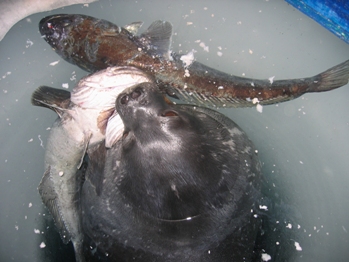 A number of species depend on Antarctic toothfish. Seen here a Wedell seal eats an Antarctic toothfish. Photo by: Jessica Meir. |
David Ainley: The Ross Sea toothfish industry can not continue to make a profit, in fact it is not even now making a profit owing to the high expense of going to the Ross Sea etc. Once they deplete all the large fish, it will take the vessels significantly longer to fill their holds. Thus, the time and therefore the expense of fishing will increase greatly. This is one reason that the industry has applied for MSC certification: so that they can increase the already very high price for these fish to unsuspecting, well off shoppers who want not to be part of depleting the ocean. They are willing to pay a higher price knowing damage has not resulted from their choice of food. A number of environmental organizations, backed by a few dozen marine scientists with direct experience in the Ross Sea, have objected to the MSC certification. Currently, the consulting firm which does the certifications for MSC is trying to address the objections raised.
Mongabay: What types of food dishes contain Antarctic toothfish? Who’s eating this species?
David Ainley: These fish sell at $20-35/pound in the fish market. Only very well-off persons can afford to eat this fish, which is served in many different ways (as Chilean sea bass)…but only little bites are affordable.
SAVING THE ROSS SEA
Mongabay: How do you propose to protect the Ross Sea from overfishing and other threats?
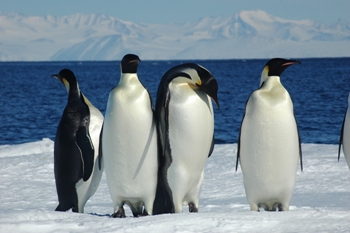 Emperor penguins. Photo courtesy of David Ainley. |
David Ainley: The body that oversees the exploitation of the Southern Ocean, which unlike the Antarctic continent, IS NOT protected, is hoping to set up a network of marine protected areas in the next few years. This is called CCAMLR (Convention for the Conservation of Antarctic Marine Resources), a name that sounds more glorious than what it actually represents owing to the fact that any country can nix any measures to conserve the resources —and it takes only one—despite the fact that there are many member-nations of CCAMLR who would like to see far less exploitation.
Indeed, the shores of the Ross Sea (and the rest of the continent) are fully protected in a World-park type arrangement, and oil and other mineral development is prohibited. Exploitation for the biotic resources of the Southern Ocean, however, is mostly a free-for-all (countries kill whales, or fish mostly to their hearts’ content). We hope that CCAMLR somehow develops the strength to establish a network of marine protected areas, and that the Ross Sea is one of them.
Mongabay: Since the Ross Sea is in the Antarctic, who would monitor the protected area if created?
David Ainley: The Ross Sea is home to the Antarctic national research programs of 3 and soon to be 4 countries: USA, New Zealand, Italy and South Korea. Japan has also spent significant time there, although in the capacity of ‘scientific whaling’. There is a lot of traffic by research ships and aircraft. There are also capabilities of using satellite technology to detect fishing vessels.
Mongabay: There is a documentary being prepared about the Ross Sea. Does it have a release date? Where will people be able to see the film once it comes out?
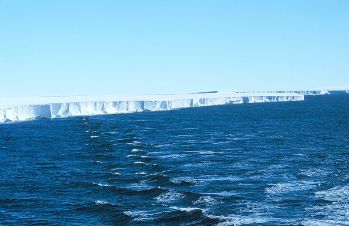 The Ross ice shelf in 1997. Photo by: Nathaniel B. Palme, NOAA. |
David Ainley: This is a dream that will come true if financing can be secured to do the final composition and editing of a huge amount of film footage collected over the past few years. Perhaps it would be available in theatres, but more probably on TV.
Mongabay: How optimistic are you that the Ross Sea will be saved?
David Ainley: There is a hope, but it only takes a few greedy people to despoil such a place as the Ross Sea. Myriad examples exist.
Mongabay: How can people help save the Ross Sea?
David Ainley: Please do not purchase Chilean sea bass (Antarctic toothfish) in any form, regardless of what stories you hear from the Marine Stewardship Council or the fishing industry. Otherwise, if you know some ecologically conscious people with disposable income, we could use funding to prepare the Last Ocean film thereby to better educate people about what Earth, and its oceans, once was like.
For more information: The Last Ocean and The Antarctic and Southern Ocean Coalition.
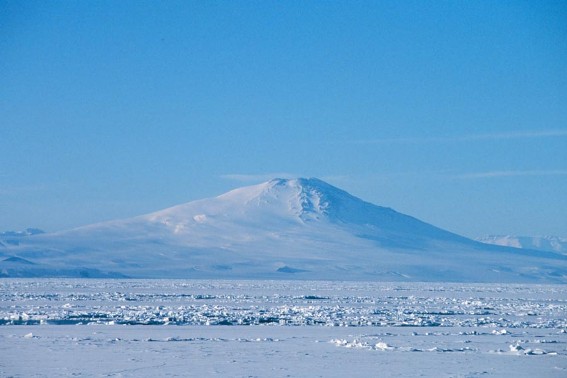
Mount Melbourne on the Ross Sea coastline. Photo by: Michael Van Woert, NOAA.
A Ross Sea killer whale (a distinct species). Photo courtesy of David Ainley.
Related articles
The penguin crisis: over 60 percent of the world’s penguins threatened with extinction

(06/10/2010) Everyone loves penguins. With their characteristic black-and-white ‘tuxedo’ markings, upright waddle, and childlike stature, penguins seem at once exotic and familiar: exotic because they live far from most human habitations, familiar because they appear innumerable books and movies. From Mr. Popper’s Penguins to Happy Feet, and from March of the Penguins to And Tango Makes Three, penguins pop-up everywhere. The flightless birds have even provided the name and symbol to one of the world’s most successful publishing houses. Yet despite their popularity amid the human kingdom, few people seem aware that penguins worldwide are facing an extinction crisis.
The good old days: 17 times easier to catch fish in 1889
(05/05/2010) It is widely recognized that fish populations have dropped drastically over the past century, but a new study in Nature Communications shows the decline may be worse than expected. Research from the University of York and the Marine Conservation Society has discovered that it was 17 times easier in the UK to catch fish in 1889—when ships were powered by sail—than it is today using high-powered motor boats with technological advances.
Killer whales split into three separate species
(04/25/2010) Using genetic evidence scientists have discovered that the world’s killer whales, also known as orcas (Orcinus orca), likely represent at least three separate species.
World failing on every environmental issue: an op-ed for Earth Day

(04/22/2010) The biodiversity crisis, the climate crisis, the deforestation crisis: we are living in an age when environmental issues have moved from regional problems to global ones. A generation or two before ours and one might speak of saving the beauty of Northern California; conserving a single species—say the white rhino—from extinction; or preserving an ecological region like the Amazon. That was a different age. Today we speak of preserving world biodiversity, of saving the ‘lungs of the planet’, of mitigating global climate change. No longer are humans over-reaching in just one region, but we are overreaching the whole planet, stretching ecological systems to a breaking point. While we are aware of the issues that threaten the well-being of life on this planet, including our own, how are we progressing on solutions?
History repeats itself: the path to extinction is still paved with greed and waste

(04/05/2010) As a child I read about the near-extinction of the American bison. Once the dominant species on America’s Great Plains, I remember books illustrating how train-travelers would set their guns on open windows and shoot down bison by the hundreds as the locomotive sped through what was left of the wild west. The American bison plunged from an estimated 30 million to a few hundred at the opening of the 20th century. When I read about the bison’s demise I remember thinking, with the characteristic superiority of a child, how such a thing could never happen today, that society has, in a word, ‘progressed’. Grown-up now, the world has made me wiser: last month the international organization CITES (Convention on International Trade in Endangered Species) struck down a ban on the Critically Endangered Atlantic bluefin tuna. The story of the Atlantic bluefin tuna is a long and mostly irrational one—that is if one looks at the Atlantic bluefin from a scientific, ecologic, moral, or common-sense perspective.
CITES chooses ‘commerce’ over sharks, leaving endangered species vulnerable

(03/23/2010) Only the porbeagle shark received protection today from the Convention on International Trade in Endangered Species (CITES). Seven other shark species failed to win international protection despite plummeting populations due to overfishing. Once again, Japan led the opposition to regulating the trade in white-tipped sharks and scalloped hammerheads, including two look-alike species: the great hammerhead and the smooth hammerhead. Japan has dominated the CITES meeting, successfully leading resistance to banning the trade in the Critically Endangered Atlantic bluefin tuna and against monitoring the coral trade.
86 percent of dolphins and whales threatened by fishing nets
(02/07/2010) A new report from the United Nations Environment Program (UNEP) finds that almost 9 out of 10 toothed whales—including dolphins and porpoises—are threatened by entanglement and subsequent drowning from large-scale fishing operations equipment, such as gillnets, traps, longlines, and trawls. These operations threaten the highest percentage (86 percent) of the world’s toothed whales.
Huge demand for omega-3 fatty acids depleting oceans worldwide for aquaculture
(09/09/2009) The ever-growing demand for fish and fish oil due to their omega-3 fatty acids has led to exponential growth in the aquaculture industry—and depletion of the world’s oceans. While aquaculture is farmed fish, the fish are fed with wild marine species.
